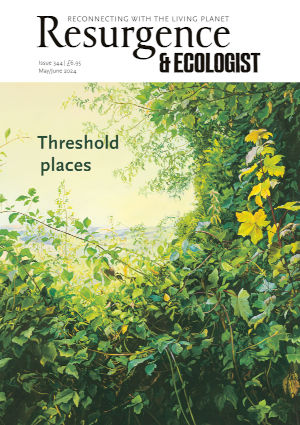It is clear from the outset that this is no dry, academic study of language. In the foreword, Manchán Magan tells us: “Since Irish predates our current fixation on reason and rationality and is more in tune with a mythological worldview, it offers a wider sense of reality, a different prism through which to regard existence… So, buckle up, this is going to be a deep dive.”
And the adventure he promises doesn’t disappoint. Originally published by Gill Books in 2020, this updated edition of Thirty-Two Words for Field is a beautifully written, engaging and often surprising account of one man’s love affair with his first language. Magan’s words are complemented by Steve Doogan’s illustrations, which grace the cover and every chapter – a wonderful evocation of the land that in many ways gave birth to the language the author loves so much. Magan writes: “An Ghaeilge, to give it its proper title (or Gaelic, as it’s called outside Ireland) … has encoded within it the accumulated knowledge of a people who have been living sustainably on these rocky, verdant Atlantic islands for millennia. As a result, it is profoundly ecological, with an innately indigenous understanding that prioritises nature and the land above all things.”
Just as important, he says, is the ability of the language to convey “the magic that our ancestors perceived in the … other-worldly realms that surround it. Words were believed to have the ability not only to describe things but actually to help summon them into being.” And chapter titles such as: Netherworld, Wave as Goddess, Fairy Words, Irish Songlines, Finding Witches and Divine Inspiration offer clues to the territory we are being invited into.
As a child, the author spent part of each year in the West Kerry Gaeltacht speaking Irish, and the rest of the time in an affluent suburb of Dublin, where he and everyone else spoke only English. It was then that he became aware that the two languages required “not just different forms of grammar and syntax but different ways of interpreting reality”.
Magan interweaves his narrative with references to folklore, history, geography, politics and science. And he draws fascinating parallels: the similarity, for example, between the names of the cailleach, the Irish goddess of winter, and the Hindu goddess Kali; or the striking resemblance between the word for shamrock (seamróg), Ireland’s national symbol, and the pre-Islamic Pagan Arabic word shamrakh.
I was amazed by the dizzying number of words representing different aspects of the same thing. Or the flexibility of a single word that can mean two seemingly opposite things: the Irish for wave, tonn, can be both a single wave and the whole ocean, depending on the context. I came across words I loved – siolla, for instance, means both a syllable and a glint of light – and was frustrated at my inability to even imagine how some of the words might be pronounced. This was the only negative in what felt like an exhilarating joyride through a world of knowledge that expanded far beyond a study of words.
Magan lives in an oak wood in County Westmeath, where he tends bees and hens, and he has been known to tour Ireland with a show in which he bakes sourdough bread while the audience churns butter. He is a descendant of Michael O’Rahilly, who fought for the revival of Irish in the late 19th and early 20th centuries, and he earned an Irish degree from University College, Dublin. He would thus seem eminently qualified to write an authoritative work on this subject, but he acknowledges the scale of the task with endearing humility: “I am no scholar of the language or of linguistics, or of anything for that matter,” he writes. “The best I can advise is to gauge for yourself what feels true … and dismiss anything that seems far-fetched or outlandish.” And so I did. But it is partly his self-deprecation, together with his erudition, his passion and a reassuringly dry wit that carries you with him.
Magan’s grandmother Sighle believed that “languages offer a connection to the inner lives of our ancestors. Old ways of thinking and living remain encoded within them”. And for that reason, it is vital that we keep them alive. The word díláthair refers to the absence felt when something or somewhere has been depopulated or destroyed by other human beings: “It is the feeling the next generation will experience in a world without coral reefs or glaciers,” he writes. “It’s also the feeling our descendants may have when they realise that we willingly chose not to pass this language on to them.” Except that, thanks to Magan and others, many of those ‘lost’ words have been found, and there is now no reason not to preserve them.
Thirty-Two Words for Field: Lost Words of the Irish Landscape by Manchán Magan. Ithaka Press, 2024. ISBN: 9781804184035.







